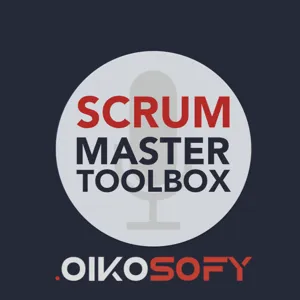BONUS: The Future Of Agility, Experiment Driven Development, With Vasco Duarte
Read the full Show Notes and search through the world’s largest audio library on Scrum directly on the Scrum Master Toolbox Podcast website: http://bit.ly/SMTP_ShowNotes.
Merry Christmas, everyone! As we bid farewell to 2023, we present the final BONUS episode of this Christmas week—a glimpse into what we believe is the future for every Agile team out there.
Brace yourselves for a deep dive into the heart of agility: learning at the speed of experimentation! Specifically, we'll explore the exciting realm of Experiment-driven development, a game-changer poised to reshape how teams approach learning and development. Don't forget, each episode this week complements the Coach Your Product Owner e-course, accessible at bit.ly/coachyourpo.
Throughout this week, we've delved into five crucial topics that every Scrum Master should master, with each topic complementing a module in the Coach Your PO e-course. Today's focus is on The spectrum of experimentation—a concept that promises to revolutionize the way teams learn and evolve.
The Spectrum of Experimentation
In previous episodes, we emphasized that writing and deploying software is the slowest and most expensive way to learn about what adds value to our product and business. Recognizing this, we introduced the idea of paper-prototype-based usability tests as a means to define and run experiments in 24 hours or less. However, this is just one facet of the vast landscape of experimentation.
Why does it matter? Not all experiments and hypotheses are created equal. While some ideas could lead to a 10x improvement in our product, others may offer incremental gains that are challenging to quantify. The key is to align the effort spent on validating hypotheses with their potential impact.
The Experiment Spectrum
Enter the experiment spectrum—a versatile range of experiments designed to collect information spanning from minutes to months. Let's explore some options based on time scales:
On the Hour Scale (Minutes):
-
User Interviews: Direct conversations with potential users.
-
Usability Tests: Quick assessments of user interaction.
-
Paper Prototype Sales: A creative experiment—sell the paper version of the app to gauge interest.
On the Day or 24-Hour Scale:
-
All of the Above: Intensify by including more interviews or tests.
-
Customer Surveys: Quick insights if you have a means to reach your audience.
-
Sales Calls with Existing Customers: Conduct a "sales pitch experiment" to validate core adoption/sales hypotheses.
On the Week or Month Scale:
-
All of the Above: Scale up for more comprehensive data.
-
Landing Page Tests: Experiment with different landing page variations.
-
Email List Tests: Leverage existing mailing lists for experiments.
-
Podcast Episodes and YouTube Videos: Engage with a wider audience.
-
Running Software in Production: The traditional approach but still a valuable part of the spectrum.
The Value of the Spectrum
This spectrum acts as a strategic tool, ensuring teams don't over-invest in validating hypotheses that might not have a significant impact on their goals. Imagine how much unnecessary code could be avoided if teams could quickly validate assumptions!
Remember, an Agile principle is to "Maximize the work not done," and that the cheapest software to operate is the one that is not developed. Code is a liability, and confidence in its value must be established before investing in development, deployment, and maintenance.
Processes are Also a Domain of Experimentation!
As Scrum Masters, we are well aware that experimentation is not limited to products—it extends to our processes. Teams cannot improve unless they are constantly learning and experimenting. One powerful approach is self-experimentation, where teams start by experimenting with their process before venturing into product experiments. This builds confidence and familiarity with the concept of running experiments.
Experiment Driven Development: Summary
Today's episode focused on the evolution from learning to Experiment-driven development. Key takeaways include:
-
Understanding the experiment spectrum—a range of experiments designed for different time scales.
-
Examples of various experiment types, from quick-hour experiments to those spanning weeks.
-
The importance of running experiments with processes before transitioning to product experiments.
All this week's episodes are companions to the Coach Your PO e-course, available at bit.ly/coachyourpo. Related modules include:
-
Version 1, Module 4: Customer Needs – A valuable concept for assessing the potential impact of hypotheses.
-
Version 1, Module 6: Quick Prioritization Techniques – Techniques applicable not just for backlogs but also for prioritizing assumptions and experiments.
-
Version 2, Module 2: Setting up Product Goals – A crucial step before running experiments.
For more details or to purchase the Coach Your PO e-course, visit bit.ly/coachyourpo.
If personalized coaching is your preference, contact us at coaching@oikosofy.com.
As we conclude this special week of bonus episodes, we invite you to reach out for more information about our products and consulting services. Remember, a rising team lifts all products!
Wishing you all a Happy New Year! See you next week for another regular week of episodes.
About Vasco Duarte
Vasco is a leading voice in the agile community, known for his contributions to the development of agile methodologies and practices. He is the co-founder of Agile Finland and the host of Scrum Master Toolbox Podcast, the most popular Agile podcast in the world, which has more than 10 000 000 unique downloads. He is also the author of “NoEstimates: A novel look at how Agile can transform software development, making it both more sustainable, as well as incredibly profitable.” Vasco is a keynote speaker at many conferences and events, sharing his knowledge and experience with the agile community. With his passion and expertise in agile, Vasco has made a significant impact on the way software development is done today, helping organizations to become more efficient, flexible, and responsive to changing requirements.lYou You can link with Vasco Duarte on LinkedIn and connect with Vasco Duarte on Twitter.

